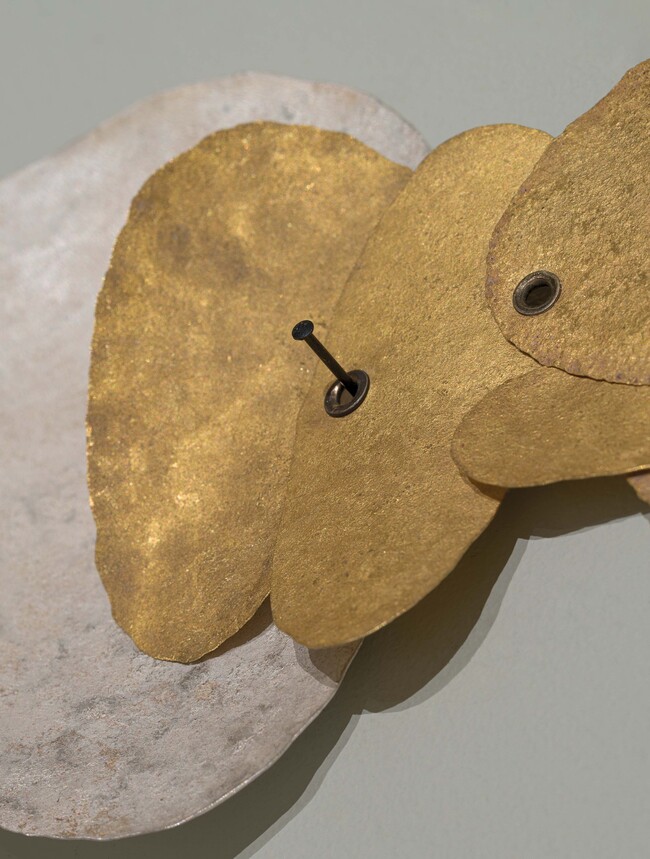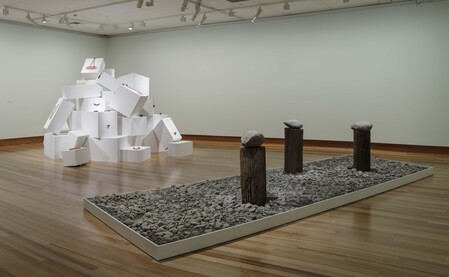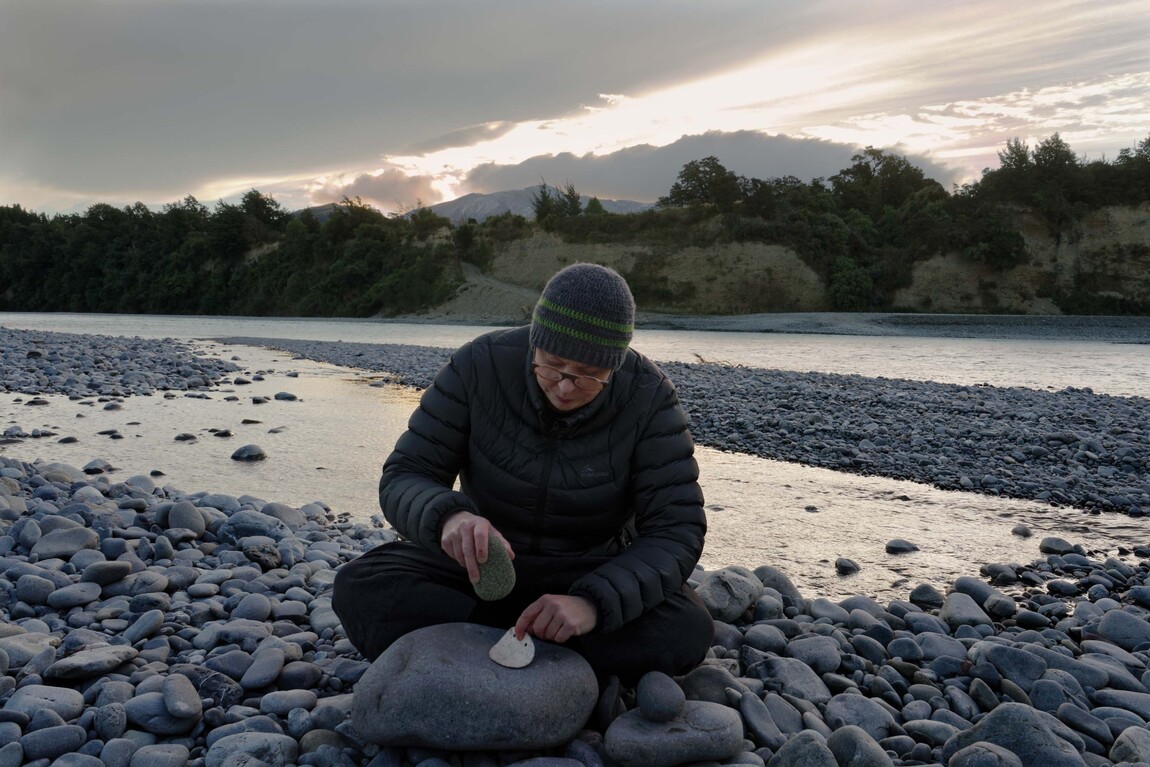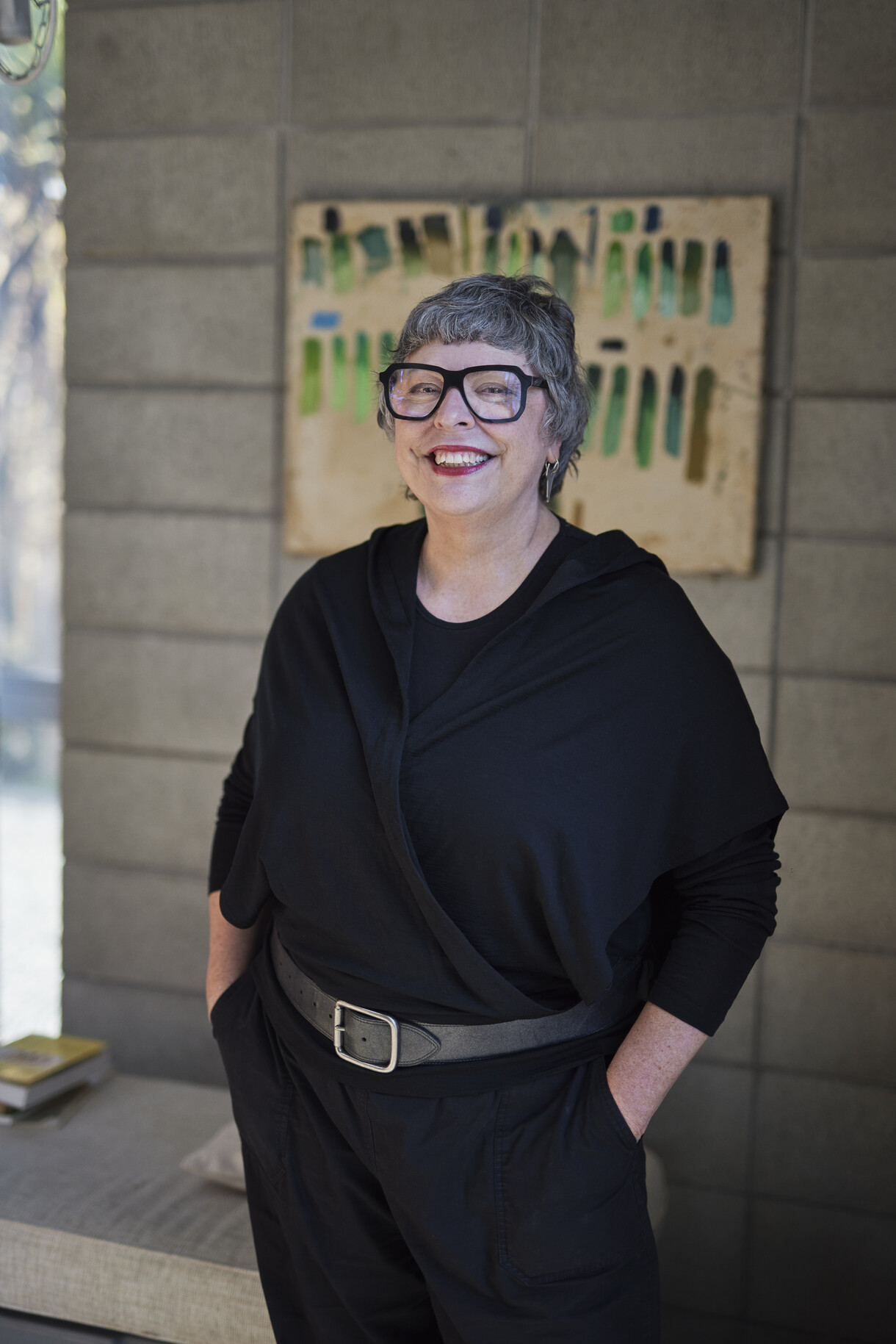Ka pai e whanaunga
Talking over Areta Wilkinson’s Moa-Hunter Fashions.

Areta Wilkinson Whakapapa II (detail) 2018. Ōtākou and Te Tai Poutini 24-carat gold, fine silver, sterling silver. Courtesy of the artist and Two Rooms, Auckland
Nathan Pōhio: We’re going to do this whānau styles.
Areta Wilkinson: Totally. We’re going to indigenise the interview process.
NP: Tēnā koe Areta, ngā mihi nui. Your project Moa-Hunter Fashions is primarily concerned with, or comes from, thinking around whakapapa and geological history, so let’s start by talking about that, and how it pertains to what you’re doing in the exhibition.

Areta Wilkinson. Photo: John Collie
AW: Kia ora, Nathan, my whanaunga from Rāpaki. You’ve asked me about whakapapa and the relationship to this exhibition, so if we go back to becoming an artist or coming into artistry, I should acknowledge my grandparents from Rāpaki – Marewa and Cliff McConnell, my tāua grandmother and pōua grandfather. And so my tāua and pōua knew your tāua and pōua at Rāpaki. In fact, and we’ve had this discussion before, your nana made beautiful little paintings. She sent them to family all over New Zealand, so we have them too.
NP: That’s right, you showed me. Elma Pōhio, from the Couch / Paipeta line, a self-taught artist and craftsperson. I think you gave one of her paintings to me actually.
AW: I gave you one of the round ones – I could see the little round view in some of your works. My tāua and pōua were involved in the Northland Māori Schools Project with Gordon Tovey. That was before Gordon really set up the integrated art in schools program. The Northland Project was the first thing that happened in the 1950s, and they were part of that. So my tāua ends up being like a Māori senior arts advisor with Gordon, and they’re developing an arts in schools programme which gets traction a bit later on. They also became involved with going onto East Coast marae looking for Māori arts and crafts specialists to teach the teachers.
So you could say that there is a whakapapa there, and it’s a mixed whakapapa. A kind of bicultural whakapapa. Integrated arts was not just Māori arts in schools – it was arts from a number of cultures, and it was cultural practices in the mainstream system.
NP: That’s amazing.

Areta Wilkinson Whakapapa II (detail) 2018. Ōtākou and Te Tai Poutini 24-carat gold, fine silver, sterling silver. Courtesy of the artist and Two Rooms, Auckland

Installation view of Areta Wilkinson: Moa Hunter Fashions showing Whakapapa I and Whakapapa IV.
AW: So I reckon that has carried through to our practice; I can see that in what you do. Certainly, in terms of whakapapa it has carried through to what I do today. I grew up in the Far North of New Zealand away from Rāpaki, and in the last fifteen years my partner and I came back down because I wanted to see how living here in the takiwā would inform my work. Just being here with those relationships, being on the land and being in place.
NP: Because that knowledge has clearly been important for all of us, but in particular we can see it clearly in the trajectory of your practice over the last several years.
AW: Well, that helped develop the doctoral research I did, and because it was kind of unpacking applied art practice using Ngāi Tahu methodology, I couldn’t be anywhere else to do that. So what was that methodology for me? It meant reaching out, learning about some of our mātauranga Ngāi Tahu and having various specialists, including whānau advisors, help me find the right tikanga for my contemporary practice. Applying that tikanga and those wisdoms into my decision-making, and responding to that knowledge.
At the same time, this return of mātauranga Ngāi Tahu, it’s not a new idea, our whānui are doing it around us all the time. I am benefiting from that cultural knowledge, but I also aspire to contribute back cultural knowledge. So that’s the PhD in practice there. Making my own work, but being culturally responsive and culturally responsible.
NP: Kia ora! Your PhD lands at a particular time within the history of the iwi, within the history of New Zealand culture and society. The timeliness of it is really interesting, but what you are talking about is a continuity, isn’t it. Continuity is significant?
AW: Definitely continuity – I feel like my work talks to that all the time because, of course, my Ngāi Tahu whakapapa goes into Polynesia and it goes beyond Polynesia. We also go back to those early whalers and sealers and their people, so there’s a mixed whakapapa there.
In my own work I consider personal adornment traditions from Aotearoa, particularly Te Waipounamu, but I’m also a gold and silversmith and that joins up with the other whakapapa on my dad’s side. I was trained in Western art practices, I wasn’t trained in the traditional whare wānanga.
NP: I guess that feeds back in to a part of what I’m thinking in that, to my knowledge, there was no opportunity to get training/mātauranga Ngāi Tahu, tikanga Māori support in the specific disciplines we sought. Although we were trained in a Western tradition, this moment is significant I think, and whakapapa has everything to do with that.
AW: I love that concept, the wāhi ngaro, the place for the lost portions of knowledge.
NP: That’s interesting.
AW: If we look at taonga tūturu for example, historical objects that our ancestors crafted, those objects are mātauranga Māori, they contain all the knowledge it took to make them. We might not necessarily be able to unlock all that, but there are other ways that we can engage with that knowledge. Because I trained in contemporary jewellery, but was thinking of it in the larger context of Te Ao Ngāi Tahu, I had to go back to early adornments and an art history from Te Waipounamu. These were some of the earliest forms made by our ancestors that have endured the test of time.
There is a lot to unpack just looking at those taonga, and then there’s a whole lot of unlearning to do, because the museum authority has framed those objects in certain ways. Actually that also feeds into this exhibition here because it is a reclaiming. Some of the ceramic forms in the exhibition relate to past production but importantly they’re not trying to be the same thing; they are remembering some of those forms that our early people made, or remembering through the use of some of the early tools our people made.
There’s a set of 3D printed metal tools in the exhibition, they’re digital replicas of tools that Henry Devenish Skinner sent to the Museum of Archaeology and Anthropology at the University of Cambridge, England. Skinner was the director down at Otago University Museum from 1937 until 1953, and swapped stuff out around the globe. This is a toolset, but museums can’t really do anything with the tools, they can only show the pieces and frame them in a certain way.
NP: But you get to create with them…
AW: Yes, through that 3D printing process, and a whakapapa approach, I can do what the museums can’t do – actually find out what marks those tools make.
So all these ceramic works in the exhibition have a whakapapa link to my set of tools through the marks that those tools make. But the whakapapa links goes back to the objects themselves in the Museum of Archaeology and Anthropology, and then back beyond to our ancestors, the craftsmen and women who made and used them, then the land itself. And that’s the stuff that I’m interested in – having those past practices in the picture at the same time that I’m making work today. That, again, is back to this idea of continuum, because it’s not a chronological concept. In the Māori world view time and space can converge, our ancestors can be with us all the time. This is another way of thinking about things.
Similarly you and I have been a journey with Paemanu,1 well, actually we’re all kind of working in this space.
NP: We’ve converged, haven’t we?
AW: We’ve converged through Paemanu and we’ve paid a lot of attention, for example, to pigments like kōkōwai, red ochre, and the mark making of our early ancestors, and so this exhibition features a number of kōkōwai pendants. Actually there are a couple there that are coal from Matakaea in Otago towards Moeraki. That’s a tribute to that history, those first mark makers and our first art galleries, so to speak. Interestingly there’s a seam of coal in the same place as this kōkōwai is found. So they’re related, they come from the same whenua, they’re in the same place and they both make marks – you’ve got a black mark and all these different shades of red. The simple practice of putting a hole through something with a cord means that you can travel with it, and the pieces did travel; they travelled all over the country and all over the world.

Areta Wilkinson working on Whakapapa I, 2018, on the Waimakariri River. Photo: Studio La Gonda

Areta Wilkinson Whakapapa II (installation view and detail) 2018. Ōtākou and Te Tai Poutini 24-carat gold, fine silver, sterling silver. Courtesy of the artist and Two Rooms, Auckland
NP: It’s extraordinary to think that the material, as an adornment, as a tool, travels by becoming a pendant or something worn, if that’s what you want to call it.
AW: Personal adornment was not just about heightened status or beautification and all of those other things, but it was also how we moved the things that we needed around. Then, thinking about painted marks on rock shelters informs pieces like Whakapapa II with its gold and silver units.
You and I have visited some of those places where ancestors have painted the rocks and seen the layers and layers of marks. Maybe people returned and made marks and other people added their marks as well. And so this is an assemblage of narratives of place because the fine metals in this work are textured using, again, those stone tools of the early people. I am thinking about what stones I’m using from particular ancestral rivers, and that those rivers have a whakapapa that includes the geology associated with those places. By using stones from an area, there is a memory from the stone that imprints onto the materials. The river is an identity marker for Ngāi Tūāhuriri, which is why the Moa-Hunter Fashions installation includes the sound of water and shingle from the riverbed, the Waimakariri.
NP: Whakapapa II is so resonant of our experience when we were staying down at Moeraki and heading into Takiroa and Maerewhenua. The experience of coming into those lean-tos, what a fantastic day that was. 2
AW: We don’t understand the symbols of the old rock paintings. Similarly, here [in Whakapapa II] are mysteries that viewers can only guess at – maybe flying things or swimming things, or humanoid shapes. There are also negative spaces where am thinking about midden – the refuse, the leftovers – and attributing these as well. Which leads me to the other midden material in the exhibition, the silver bromide photograms, which are a collaborative work between Mark Adams and myself. On the left are moa bones from Glenmark Waipara, now in Leeds Museum, and on the right, miscellaneous bones from a “Moa Hunter Camp” at Shag River Waihemo in their little plastic bags in the British Museum.
The connection is mahinga kai and evidence of occupation or production, now in museums overseas. That this material is overseas relates to the swapping out that museum directors were doing in New Zealand. Those moa bones came out of somewhere in Glenmark and Waipara, and that’s Von Haast from Canterbury Museum swapping works around the globe – “I’ll give you this and do you have one of these?” And the other photogram relates to H. D. Skinner, down at Otago Museum, swapping material stuff with the British Museum. In fact, those 3D printed tools also relate to Skinner sending objects to director Von Hugel at the Museum of Archaeology and Anthropology, Cambridge. So this is all about a fascination with otherness including Māori culture.
NP: That these disjointed or dislocated things have been moved around the planet by these guys is fascinating in its wrongness.
AW: As Māori artists, we’re moving beyond decolonising, and it’s more about indigenising, which speaks to our kaupapa Ngāi Tahu far better. But as I mentioned at the mihi whakatau for the opening of the exhibition Moa-Hunter Fashions, it comes at the same time as the moa-hunter diorama over at the Canterbury Museum is being critiqued. Now, that is its own thing, but this exhibition is called Moa-Hunter Fashions because of Roger Duff and the authoritative work he has done around personal adornment. 3 Most of the personal adornment in that book The Moa-Hunter Period of Māori Culture, that cultural material is held in the Canterbury Museum. This thesis is a colonial record of the archaeological digs from graves recorded, measured out and surmised.
I would prefer if the moa-hunter diorama were reframed with a label that says, “This is museum culture from the nineteenth and twentieth century” thereby putting the museum also into the vitrine. The main point regarding the whakaaro is that Māori culture is happening all the time and in the places that it needs to happen.
Areta Wilkinson spoke with Nathan Pōhio in September 2020. Areta Wilkinson: Moa-Hunter Fashions is on display until 8 February 2021.









